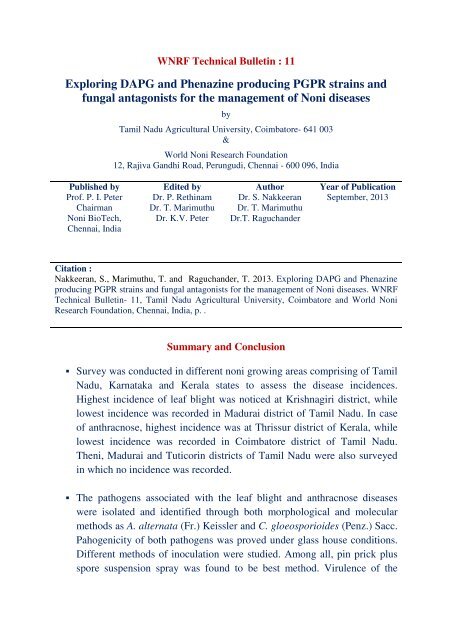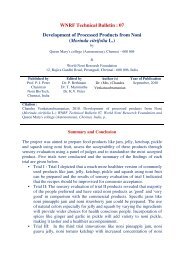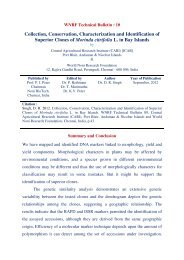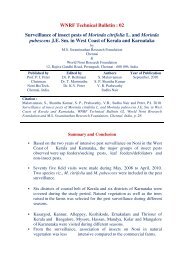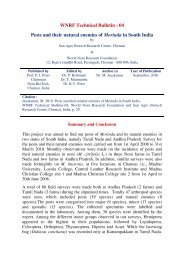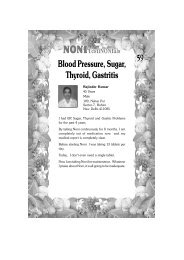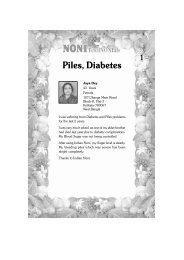Exploring DAPG and Phenazine producing PGPR strains and fungal ...
Exploring DAPG and Phenazine producing PGPR strains and fungal ...
Exploring DAPG and Phenazine producing PGPR strains and fungal ...
You also want an ePaper? Increase the reach of your titles
YUMPU automatically turns print PDFs into web optimized ePapers that Google loves.
WNRF Technical Bulletin : 11<br />
<strong>Exploring</strong> <strong>DAPG</strong> <strong>and</strong> <strong>Phenazine</strong> <strong>producing</strong> <strong>PGPR</strong> <strong>strains</strong> <strong>and</strong><br />
<strong>fungal</strong> antagonists for the management of Noni diseases<br />
by<br />
Tamil Nadu Agricultural University, Coimbatore- 641 003<br />
&<br />
World Noni Research Foundation<br />
12, Rajiva G<strong>and</strong>hi Road, Perungudi, Chennai - 600 096, India<br />
Published by<br />
Prof. P. I. Peter<br />
Chairman<br />
Noni BioTech,<br />
Chennai, India<br />
Edited by<br />
Dr. P. Rethinam<br />
Dr. T. Marimuthu<br />
Dr. K.V. Peter<br />
Author<br />
Dr. S. Nakkeeran<br />
Dr. T. Marimuthu<br />
Dr.T. Raguch<strong>and</strong>er<br />
Year of Publication<br />
September, 2013<br />
Citation :<br />
Nakkeeran, S., Marimuthu, T. <strong>and</strong> Raguch<strong>and</strong>er, T. 2013. <strong>Exploring</strong> <strong>DAPG</strong> <strong>and</strong> <strong>Phenazine</strong><br />
<strong>producing</strong> <strong>PGPR</strong> <strong>strains</strong> <strong>and</strong> <strong>fungal</strong> antagonists for the management of Noni diseases. WNRF<br />
Technical Bulletin- 11, Tamil Nadu Agricultural University, Coimbatore <strong>and</strong> World Noni<br />
Research Foundation, Chennai, India, p. .<br />
Summary <strong>and</strong> Conclusion<br />
Survey was conducted in different noni growing areas comprising of Tamil<br />
Nadu, Karnataka <strong>and</strong> Kerala states to assess the disease incidences.<br />
Highest incidence of leaf blight was noticed at Krishnagiri district, while<br />
lowest incidence was recorded in Madurai district of Tamil Nadu. In case<br />
of anthracnose, highest incidence was at Thrissur district of Kerala, while<br />
lowest incidence was recorded in Coimbatore district of Tamil Nadu.<br />
Theni, Madurai <strong>and</strong> Tuticorin districts of Tamil Nadu were also surveyed<br />
in which no incidence was recorded.<br />
The pathogens associated with the leaf blight <strong>and</strong> anthracnose diseases<br />
were isolated <strong>and</strong> identified through both morphological <strong>and</strong> molecular<br />
methods as A. alternata (Fr.) Keissler <strong>and</strong> C. gloeosporioides (Penz.) Sacc.<br />
Pahogenicity of both pathogens was proved under glass house conditions.<br />
Different methods of inoculation were studied. Among all, pin prick plus<br />
spore suspension spray was found to be best method. Virulence of the
isolates was studied, among fifteen isolates of A. alternata isolate AA1<br />
was found to be highly virulent whereas, among ten isolates in case of C.<br />
gloeosporioides, C1 was found to be highly virulent.<br />
Morphological <strong>and</strong> molecular variation among the isolates of A. alternata<br />
<strong>and</strong> C. gloeosporioides were studied. The result revealed that there was a<br />
wide variation with respect to morphological <strong>and</strong> cultural characters of the<br />
isolates. With respect to molecular variation, among fifteen isolates of A.<br />
alternata, seven isolates from Tamil Nadu <strong>and</strong> two isolates from Karnataka<br />
formed one group. While the other three isolates belonging to Karnataka,<br />
two isolates from Kerala <strong>and</strong> one isolates from Tamil Nadu formed another<br />
group. In case of C. gloeosporioides out of ten isolates, five isolates from<br />
Tamil Nadu <strong>and</strong> one isolate from Kerala formed one group (Group A).<br />
Four isolates from Karnataka formed another group (Group B).<br />
Histopathological studies were carried out in leaves infected with A.<br />
alternata <strong>and</strong> C. gloeosporioides <strong>and</strong> the results indicated there was pink<br />
staining of cortex cells, <strong>and</strong> irregular thickening of cell wall with dense <strong>and</strong><br />
granular cytoplasm in both case. In case of C. gloeosporioides infected<br />
leaves complete disintegration of palisade parenchyma was noticed.<br />
Different isolates of P. fluorescens, B. subtilis <strong>and</strong> T. viride were tested<br />
against both the pathogens under in vitro. Among all, Pf1 <strong>and</strong> TDK1 of P.<br />
fluorescens EPC8 <strong>and</strong> SVPR4 of B. subtilis <strong>and</strong> TV1 of T. viride were<br />
found to be highly effective against A. alternata <strong>and</strong> C. gloeosporioides,<br />
respectively. Compatibility among the effective bioagents was studied <strong>and</strong><br />
all effective isolates were found to be compatible with each other.<br />
The induction of defense mechanisms in noni by different bioformulations<br />
treated plants showed increased activity of peroxidase, polyphenol oxidase,<br />
catalase <strong>and</strong> phenylalanine ammonia lyase in response to the leaf blight<br />
<strong>and</strong> anthracnose pathogens. The expression pattern of PO, PPO <strong>and</strong><br />
proteins through native PAGE <strong>and</strong> SDS PAGE respectively, showed extra<br />
isoforms in bioformulations treated seedlings against pathogen inoculation.<br />
Efficacy of effective bioagents in vermicompost <strong>and</strong> neem cake based<br />
formulation as well as liquid formulations was tested against leaf blight
<strong>and</strong> anthracnose under glass house as well as field conditions. The result<br />
indicated that soil application of vermicompost, neem cake <strong>and</strong><br />
Pf1+EPC8+TV1 mixture in the ratio 8:1:1 <strong>and</strong> foliar spray of liquid<br />
formulation of Pf1+EPC8+TV1 mixture @ 0.2% were highly effective in<br />
reducing incidence of leaf blight both under glass house <strong>and</strong> field<br />
conditions. In addition the same treatment recorded higher yield compared<br />
to other treatments. Similarly for anthracnose the treatment, soil<br />
application of vermicompost, neem cake <strong>and</strong> TDK1+SVPR4+TV1<br />
mixture in the ratio 8:1:1 <strong>and</strong> foliar spray of liquid formulation of<br />
TDK1+SVPR4+TV1 mixture @ 0.2% was highly effective in reducing<br />
incidence besides increasing yield.<br />
The survey was undertaken to assess the incidence of fruit rot diseases in five<br />
districts across Tamil Nadu <strong>and</strong> Kerala. The result revealed that the highest<br />
incidence of dry fruit rot caused by C. gloeosporioides was observed to an<br />
extent of 71.40% in Coimbatore. The incidence of dry fruit rot caused by A.<br />
alternata was found to be maximum in Viasa of Trissur district (45.00%), The<br />
highest percent incidence of wet fruit rot was assessed in Coimbatore (63.3 %)<br />
it was followed by Aliyar Nagar (52.00 %) in Tamil Nadu.<br />
Noni fruit being affected by two types of fruit rot diseases namely dry fruit<br />
rot <strong>and</strong> wet fruit rot. Dry fruit rot is associated with C. gloeosporioides <strong>and</strong><br />
A. alternata with marked difference in their symptoms, whereas soft fruit<br />
rot was caused by bacterial pathogen P. agglomerans. In pathogenicity test<br />
C. gloeosporioides, A. alternata <strong>and</strong> P. agglomerans reproduced fruit rot<br />
symptoms which were similar to natural infection.<br />
The causal organisms of dry fruit rot were identified as C. gloeosporioides <strong>and</strong><br />
A. alternata based on their based on their morphological <strong>and</strong> cultural<br />
characters. The pathogen responsible for wet fruit rot was identified as P.<br />
agglomerans based on the morphological <strong>and</strong> biochemical characters further it<br />
was confirmed by FAME <strong>and</strong> 16s rDNA.<br />
Histapathological studies on dry fruit rot sample revealed structural<br />
changes <strong>and</strong> presence of pathogens propagules in infected fruit tissues.<br />
About eighteen Bacillus isolates consist endophytic <strong>and</strong> non endophytic<br />
were isolated from different crop growing areas <strong>and</strong> named BS1 to BS18.
Molecular detection of antibiotics biosynthetic genes revealed presence of<br />
surfactin gene in all 18 Bacillus isolates.<br />
Bacillus isolates BS1, BS2, BS3, BS4, BS6, BS7, BS8, BS10, BS11,<br />
BS13, BS14 <strong>and</strong> BS18 <strong>strains</strong> were amplified for iturin gene. Strains of<br />
B.subtilis BS1, BS2, <strong>and</strong> BS8 expressed bacillomycin gene. The genomic<br />
DNA of the <strong>strains</strong> BS1, BS2, BS4, BS6, BS7 BS8, BS11, BS14, <strong>and</strong> BS16<strong>and</strong><br />
BS18 showed positive for fengycin gene.<br />
In vitro screening of Bacillus revealed the isolates BS2 showed highest<br />
inhibition against C. gloeosporioides, <strong>and</strong> A. alternata to an extend of<br />
56.67 <strong>and</strong> 61.11 percent over control respectively. The anti<strong>fungal</strong> activity<br />
of antagonistic Bacillus against C. gloeosporioides, <strong>and</strong> A. alternata was<br />
confirmed by observing abnormal swelling <strong>and</strong> lysis of conidia <strong>and</strong><br />
mycelium of <strong>fungal</strong> pathogens scrapped from the zone of interaction.<br />
Antagonistic activity of Bacillus isolates against P. agglomerans revealed the<br />
isolate BS2 was found to record high inhibition zone of 28 mm. Crude<br />
antibiotics were extracted from Bacillus (BS2) using different organic<br />
solvents like ethyl acetate, methanol, hexane <strong>and</strong> butanol. Among different<br />
solvents used ethyl acetate extraction was found with high bioactivity<br />
against C. gloeosoporioides, A. alternata <strong>and</strong> P. agglomerans.<br />
Ethyl acetate was used to extract crude antibiotics from BS1, BS2, BS6<br />
<strong>and</strong> BS8 .Bioassay of crude antibiotics against C. gloeosporioides <strong>and</strong> A<br />
.alternata revealed isolates BS2 inhibited C .goleosporioides <strong>and</strong> A.<br />
alternata to an extent of 59.11% <strong>and</strong> 64.22 respectively. Antibacterial<br />
activity of crude antibiotics against P. agglomerans was tested among<br />
various isolate the BS2 recorded the maximum inhibition zone (29.00mm).<br />
Sensitivity of crude antibiotics from Bacillus spp to different temperature<br />
was assessed. The antimicrobial activity of crude antibiotics showed<br />
highest inhibitory activity against fruit rot pathogens at 40 ° C. But degree<br />
bioactivity was declined after exposure to 120 ο C for 15 min.<br />
Thin layer chromatography studies revealed that the Bacillus isolates BS1,<br />
BS2, <strong>and</strong> BS8 were observed the antibiotics surfactin <strong>and</strong> iturin with the R f<br />
value of 0.3 <strong>and</strong> 0.7 respectively. GCMS studies on crude antibiotics
identified antimicrobial compound belonging to fatty acid, lipopeptide,<br />
peptide, <strong>and</strong> aldehydes which are responsible for anti<strong>fungal</strong> <strong>and</strong><br />
antibacterial activity.<br />
Finally the bio-efficacy of Bacillus isolates was tested under field<br />
condition. Among different dosages tested the foliar spray with 5 % of BS2<br />
shown minimum disease incidence of dry <strong>and</strong> soft fruit rot.<br />
---------------------------------End of statement--------------------------------------


